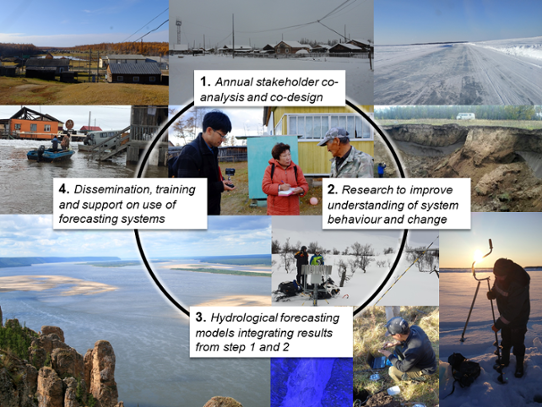– Historically human populations in Yakutia have lived on frozen ground and clustered along the rivers, which makes them vulnerable to flooding during the spring ice breakup period. Climate change impacts can be seen on land where permafrost thawing leads to loss of agricultural land and changes in the landscape. River ice roads is a key component in the Yakutian transport infrastructure, and shortening of the river ice period is a major concern for the future, says David Gustafsson, researcher and project coordinator at SMHI Hydrological Research and Development group.
Studying local and regional impact
The HYPE-ERAS project will combine environmental and social knowledge to strengthen capacity for adaptation and management of the climate change effects on society and nature – so-called resilience – in Arctic and subarctic areas of Yakutia. This will be done by improving knowledge about the relationship between changes in river streamflow, ice cover and permafrost, and the corresponding social challenges (floods, ice roads sustainability, loss of agricultural land), and how these affect local and regional economy, agriculture, traditional lifestyle and cultural landscape.
Another aim is to increase resilience to climate change by developing improved tools for forecasting and future scenarios. A new forecast system for floods and ice conditions will be developed that incorporates field observations in Eastern Siberia, new satellite measurements and existing climate services.

User involvement
The project focuses on the major rivers in Yakutia in Eastern Siberia, through collaboration between natural and social science researchers in Sweden, Russia and Japan as well as stakeholders at federal, republic, and local levels in Yakutia. The researchers in the project specialize in hydrological modelling and forecasts, permafrost hydrology, landscape changes in permafrost areas and their impact on local and regional economy, agriculture, traditional lifestyle and cultural landscape.
Transdisciplinary approach
The project is ongoing for three years 2020-2022 and contains four different main elements that are repeated each year:
- Joint transdisciplinary analysis and project design involving researchers and community actors;
- Research with the aim of improving natural and social science knowledge of systems, changes, and impacts based on field observations, remote sensing and hydrological modelling;
- Development and evaluation of hydrological forecast tools that integrate results from the previous steps
- Dissemination of knowledge, training and support for the use of forecasting tools and results from the project.

The HYPE-ERAS project was kicked-off online, April 20th – 21st 2020. Seventeen participants from Sweden, Russia and Japan took part. The project is led by Dr. David Gustafsson at the SMHI Hydrological Research and Development group.
The project is funded by FORMAS, RFBR and JST as part of the Belmont Forum’s Collaborative Research Action (CRA), Resilience in Rapidly Changing Arctic Systems (Arctic II 2019).